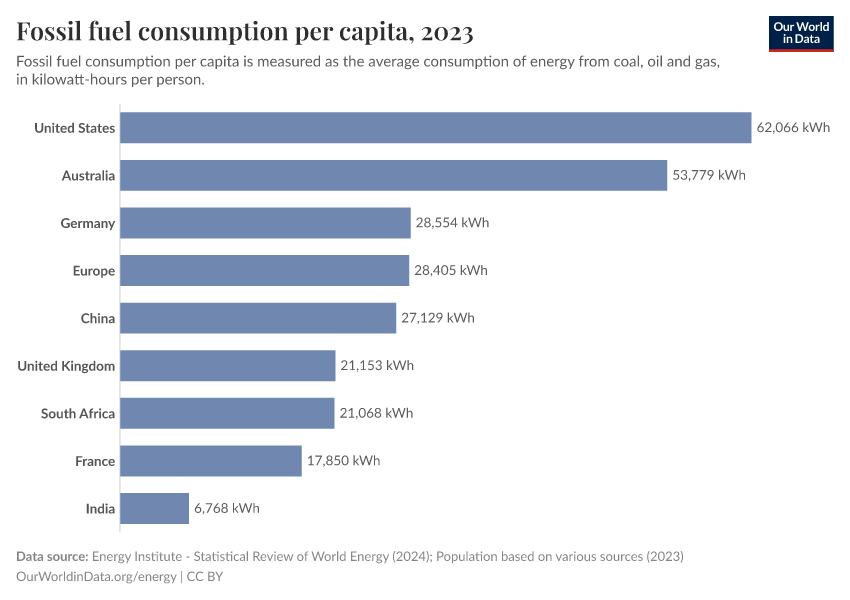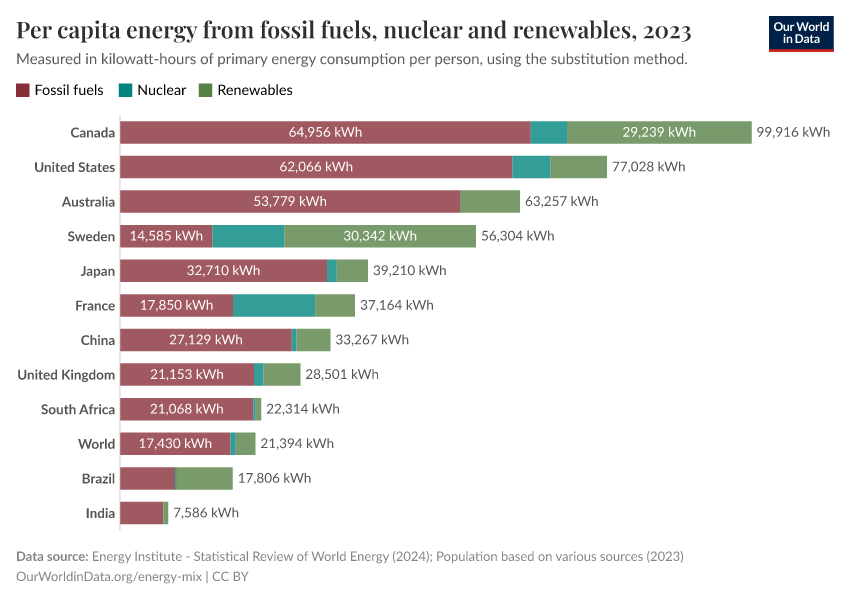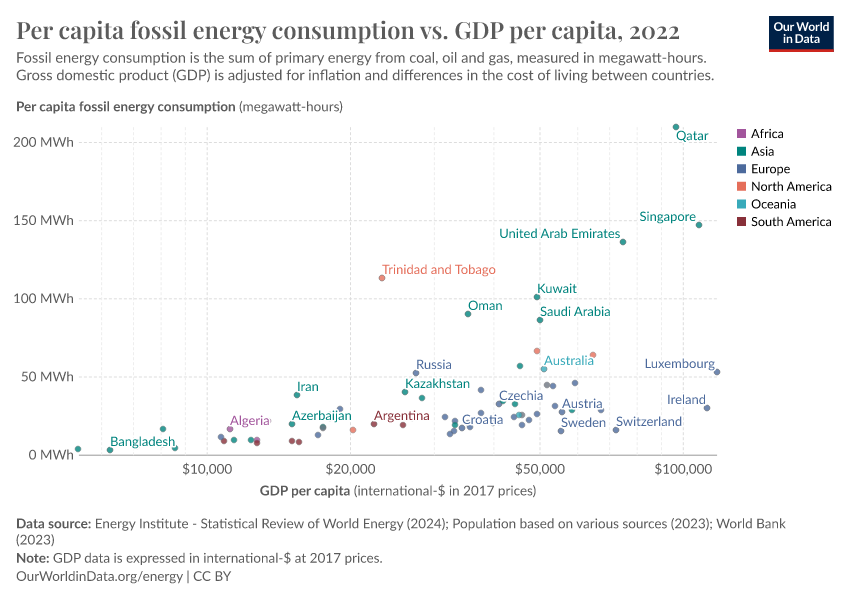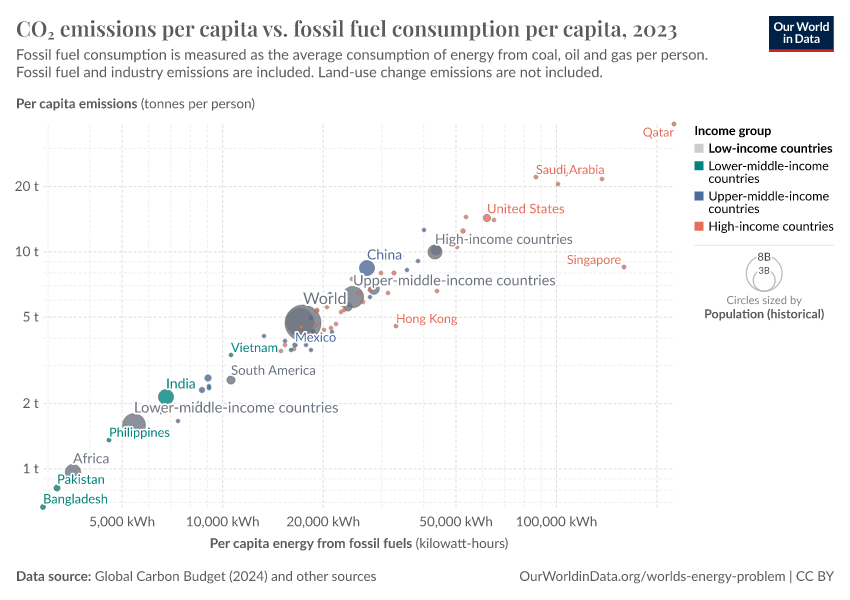Fossil fuel consumption per capita

What you should know about this indicator
- Includes commercial solid fuels only, i.e. bituminous coal and anthracite (hard coal), and lignite and brown (sub-bituminous) coal, and other commercial solid fuels. Excludes coal converted to liquid or gaseous fuels, but includes coal consumed in transformation processes. Differences between the consumption figures and the world production statistics are accounted for by stock changes, and unavoidable disparities in the definition, measurement or conversion of coal supply and demand data.
- Includes inland demand plus international aviation and marine bunkers and refinery fuel and loss. Consumption of biogasoline (such as ethanol) and biodiesel are excluded while derivatives of coal and natural gas are included. Differences between the world consumption figures and world production statistics are accounted for by stock changes, consumption of non-petroleum additives and substitute fuels and unavoidable disparities in the definition, measurement or conversion of oil supply and demand data.
- Excludes natural gas converted to liquid fuels but includes derivatives of coal as well as natural gas consumed in Gas-to-Liquids transformation. The difference between the world consumption figures and the world production statistics is due to variations in stocks at storage facilities and liquefaction plants, together with unavoidable disparities in the definition, measurement or conversion of gas supply and demand data.
- Population is the most commonly used metric throughout Our World in Data. It is used directly to understand population growth over time, and indirectly to calculate per-capita indicators, making it easier to compare countries of different sizes.
- We construct this indicator by combining multiple sources covering different periods.
- HYDE v3.3 (2023): historical estimates from 10,000 BCE to 1799.
- Gapminder v7 (2022): for 1800-1949.
- UN World Population Prospects (2024): for 1950 onwards, including 2100 projections.
- Gapminder Systema Globalis (2023): additional source for former countries (Yugoslavia, USSR, etc.)
- Breaks in the data may occur at the boundaries between sources due to their methodological differences.
- You can read more about the sources and methodology in our dedicated article. We also provide a table of sources showing the source we use for each country-year.
- We calculate geographical aggregates (continents, income groups, etc.) by summing individual country populations. For years before 1800, we rely directly on HYDE's values for continents to ensure historical consistency.
Related research and writing
What you should know about this indicator
- Includes commercial solid fuels only, i.e. bituminous coal and anthracite (hard coal), and lignite and brown (sub-bituminous) coal, and other commercial solid fuels. Excludes coal converted to liquid or gaseous fuels, but includes coal consumed in transformation processes. Differences between the consumption figures and the world production statistics are accounted for by stock changes, and unavoidable disparities in the definition, measurement or conversion of coal supply and demand data.
- Includes inland demand plus international aviation and marine bunkers and refinery fuel and loss. Consumption of biogasoline (such as ethanol) and biodiesel are excluded while derivatives of coal and natural gas are included. Differences between the world consumption figures and world production statistics are accounted for by stock changes, consumption of non-petroleum additives and substitute fuels and unavoidable disparities in the definition, measurement or conversion of oil supply and demand data.
- Excludes natural gas converted to liquid fuels but includes derivatives of coal as well as natural gas consumed in Gas-to-Liquids transformation. The difference between the world consumption figures and the world production statistics is due to variations in stocks at storage facilities and liquefaction plants, together with unavoidable disparities in the definition, measurement or conversion of gas supply and demand data.
- Population is the most commonly used metric throughout Our World in Data. It is used directly to understand population growth over time, and indirectly to calculate per-capita indicators, making it easier to compare countries of different sizes.
- We construct this indicator by combining multiple sources covering different periods.
- HYDE v3.3 (2023): historical estimates from 10,000 BCE to 1799.
- Gapminder v7 (2022): for 1800-1949.
- UN World Population Prospects (2024): for 1950 onwards, including 2100 projections.
- Gapminder Systema Globalis (2023): additional source for former countries (Yugoslavia, USSR, etc.)
- Breaks in the data may occur at the boundaries between sources due to their methodological differences.
- You can read more about the sources and methodology in our dedicated article. We also provide a table of sources showing the source we use for each country-year.
- We calculate geographical aggregates (continents, income groups, etc.) by summing individual country populations. For years before 1800, we rely directly on HYDE's values for continents to ensure historical consistency.
Sources and processing
This data is based on the following sources
How we process data at Our World in Data
All data and visualizations on Our World in Data rely on data sourced from one or several original data providers. Preparing this original data involves several processing steps. Depending on the data, this can include standardizing country names and world region definitions, converting units, calculating derived indicators such as per capita measures, as well as adding or adapting metadata such as the name or the description given to an indicator.
At the link below you can find a detailed description of the structure of our data pipeline, including links to all the code used to prepare data across Our World in Data.
Notes on our processing step for this indicator
Per capita figures are calculated by dividing by a population dataset that is built and maintained by Our World in Data, based on different sources.
Reuse this work
- All data produced by third-party providers and made available by Our World in Data are subject to the license terms from the original providers. Our work would not be possible without the data providers we rely on, so we ask you to always cite them appropriately (see below). This is crucial to allow data providers to continue doing their work, enhancing, maintaining and updating valuable data.
- All data, visualizations, and code produced by Our World in Data are completely open access under the Creative Commons BY license. You have the permission to use, distribute, and reproduce these in any medium, provided the source and authors are credited.
Citations
How to cite this page
To cite this page overall, including any descriptions, FAQs or explanations of the data authored by Our World in Data, please use the following citation:
“Data Page: Fossil fuel consumption per capita”, part of the following publication: Hannah Ritchie, Pablo Rosado, and Max Roser (2023) - “Energy”. Data adapted from Energy Institute, Various sources. Retrieved from https://archive.ourworldindata.org/20251204-144539/grapher/fossil-fuels-per-capita.html [online resource] (archived on December 4, 2025).How to cite this data
In-line citationIf you have limited space (e.g. in data visualizations), you can use this abbreviated in-line citation:
Energy Institute - Statistical Review of World Energy (2025); Population based on various sources (2024) – with major processing by Our World in DataFull citation
Energy Institute - Statistical Review of World Energy (2025); Population based on various sources (2024) – with major processing by Our World in Data. “Fossil fuel consumption per capita” [dataset]. Energy Institute, “Statistical Review of World Energy”; Various sources, “Population” [original data]. Retrieved December 22, 2025 from https://archive.ourworldindata.org/20251204-144539/grapher/fossil-fuels-per-capita.html (archived on December 4, 2025).

